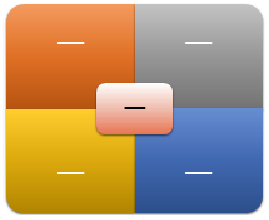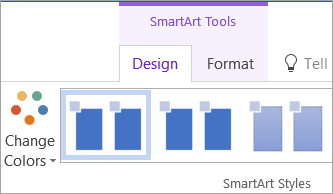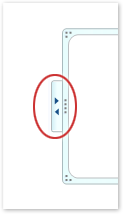Note: This article has done its job, and will be retiring soon. To prevent "Page not found" woes, we're removing links we know about. If you've created links to this page, please remove them, and together we'll keep the web connected.
A matrix is a rectangular array of elements, arranged in rows and columns, that can be used to show the placement of concepts along two axes. For example, you can use a matrix to illustrate the four possible combinations of two concepts or ingredients. By using a SmartArt graphic in Excel, Outlook, PowerPoint, or Word, you can create a matrix and include it in your spreadsheet, email message, presentation, or document.

Create a matrix
-
On the Insert tab, in the Illustrations group, click SmartArt.

-
In the Choose a SmartArt Graphic gallery, click Matrix, click a matrix layout (such as Basic Matrix), and then click OK.
-
To enter text in your matrix, do one of the following:
-
Click [Text] in the Text pane, and then type your text.
-
Copy text from another location or program, click [Text] in the Text pane, and then paste your text.
Note: If the Text pane is not visible, click the control.

-
Click a box in the SmartArt graphic, and then type your text.
-
What else would you like to do?
-
To move a box, click the box and then drag it to its new location.
-
To move a box in very small increments, hold down CTRL while you press the arrow keys on your keyboard.
-
Right-click the matrix that you want to change, and then click Change Layout.
-
Click Matrix, and then do one of the following:
-
To show the relationship of components to a whole in quadrants, click Basic Matrix.

-
To show the relationship of four quadrants to a whole, click Titled Matrix. The first line of top-level text that you type appears in the center of the matrix, and the first four lines of second-level text appear in the four quadrants.

-
To show the relationship of components to a whole in quadrants, emphasizing the quadrants rather than the whole, click Grid Matrix.

-
To show the relationship to a central idea in a cyclical progression, click Cycle Matrix.

-
For more details on each type of matrix, see Matrix type SmartArt graphic descriptions.
Note: You can also change the layout of your SmartArt graphic by clicking a layout option in the Layouts group on the Design tab under SmartArt Tools. When you point to a layout option, your SmartArt graphic changes to show you a preview of how it would look with that layout.
To quickly add a designer-quality look and polish to your SmartArt graphic, you can change the colors or apply a SmartArt Style to your matrix. You can also add effects, such as glows, soft edges, or 3-D effects.
You can apply color combinations that are derived from the theme colors to the boxes in your SmartArt graphic.
-
Click the SmartArt graphic whose color you want to change.
-
Under SmartArt Tools, on the Design tab, in the SmartArt Styles group, click Change Colors.

If you don't see the SmartArt Tools or Design tabs, make sure that you've selected the SmartArt graphic.
Tip: When you place your pointer over a thumbnail, you can see how the colors affect your SmartArt graphic.
Change the line color or style of a box's border
-
In the SmartArt graphic, right-click the border of the box you want to change, and then click Format Shape.
-
Do one of the following:
In Office 2016 and Office 2013, expand Line, and then choose the color or style that you want.
In Office 2010, click Line Color to choose a new color, and click Line style to change the stye.
Change the background color of a box in your matrix
-
Click the SmartArt graphic you want to change.
-
Right-click the border of a box, and then click Format Shape.
-
Click Fill, and then click Solid fill.
-
Click Color, and then click the color that you want.
To change the background to a color that is not in the theme colors, click More Colors, and then either click the color that you want on the Standard tab, or mix your own color on the Custom tab. Custom colors and colors on the Standard tab are not updated if you later change the document theme.
To specify how much you can see through the background color, move the Transparency slider, or enter a number in the box next to the slider. You can vary the percentage of transparency from 0% (fully opaque, the default setting) to 100% (fully transparent).
A SmartArt Style is a combination of various effects, such as line style, bevel, or 3-D, that you can apply to the boxes in your SmartArt graphic to create a unique and professionally designed look.
-
Click the SmartArt graphic you want to change.
-
Under SmartArt Tools, on the Design tab, in the SmartArt Styles group, click the SmartArt Style that you want.
To see more SmartArt Styles, click the More button
Notes:
-
When you place your pointer over a thumbnail, you can see how the SmartArt Style affects your SmartArt graphic.
-
You can also customize your SmartArt graphic by moving boxes, resizing boxes, and adding a fill or effect.
Create a matrix
-
On the Insert tab, in the Illustrations group, click SmartArt.

-
In the Choose a SmartArt Graphic gallery, click Matrix, click a matrix layout (such as Basic Matrix), and then click OK.
-
To enter text in your matrix, do one of the following:
-
Click [Text] in the Text pane, and then type your text.
-
Copy text from another location or program, click [Text] in the Text pane, and then paste your text.
Note: If the Text pane is not visible, click the control.

-
Click a box in the SmartArt graphic, and then type your text.
-
What else would you like to do?
-
To move a box, click the box and then drag it to its new location.
-
To move a box in very small increments, hold down CTRL while you press the arrow keys on your keyboard.
-
Right-click the matrix that you want to change, and then click Change Layout.
-
Click Matrix, and then do one of the following:
-
To show the relationship of components to a whole in quadrants, click Basic Matrix.

-
To show the relationship of four quadrants to a whole, click Titled Matrix. The first line of top-level text that you type appears in the center of the matrix, and the first four lines of second-level text appear in the four quadrants.

-
To show the relationship of components to a whole in quadrants, emphasizing the quadrants rather than the whole, click Grid Matrix.

-
Note: You can also change the layout of your SmartArt graphic by clicking a layout option in the Layouts group on the Design tab under SmartArt Tools. When you point to a layout option, your SmartArt graphic changes to show you a preview of how it would look with that layout.
To quickly add a designer-quality look and polish to your SmartArt graphic, you can change the colors or apply a SmartArt Style to your matrix. You can also add effects, such as glows, soft edges, or 3-D effects. Using PowerPoint 2007 presentations, you can animate your matrix.
You can apply color combinations that are derived from the theme colors to the boxes in your SmartArt graphic.
-
Click the SmartArt graphic whose color you want to change.
-
Under SmartArt Tools, on the Design tab, in the SmartArt Styles group, click Change Colors.

If you don't see the SmartArt Tools or Design tabs, make sure that you've selected the SmartArt graphic.
Tip: When you place your pointer over a thumbnail, you can see how the colors affect your SmartArt graphic.
Change the line color or style of a box's border
-
In the SmartArt graphic, right-click the border of the box you want to change, and then click Format Shape.
-
To change the color of the box's border, click Line Color, click Color

-
To change the style of the box's border, click Line Style, and then choose the line styles you want.
Change the background color of a box in your matrix
-
Click the SmartArt graphic you want to change.
-
Right-click the border of a box, and then click Format Shape.
-
Click Fill, and then click Solid fill.
-
Click Color

To change the background to a color that is not in the theme colors, click More Colors, and then either click the color that you want on the Standard tab, or mix your own color on the Custom tab. Custom colors and colors on the Standard tab are not updated if you later change the document theme.
To specify how much you can see through the background color, move the Transparency slider, or enter a number in the box next to the slider. You can vary the percentage of transparency from 0% (fully opaque, the default setting) to 100% (fully transparent).
A SmartArt Style is a combination of various effects, such as line style, bevel, or 3-D, that you can apply to the boxes in your SmartArt graphic to create a unique and professionally designed look.
-
Click the SmartArt graphic you want to change.
-
Under SmartArt Tools, on the Design tab, in the SmartArt Styles group, click the SmartArt Style that you want.

To see more SmartArt Styles, click the More button
Notes:
-
When you place your pointer over a thumbnail, you can see how the SmartArt Style affects your SmartArt graphic.
-
You can also customize your SmartArt graphic by moving boxes, resizing boxes, adding a fill or effect, and adding a picture.
If you're using PowerPoint 2007, you can animate your matrix to emphasize each box.
-
Click the matrix that you want to animate.
-
On the Animations tab, in the Animations group, click Animate, and then click One by one.

Note: If you copy a matrix that has an animation applied to it to another slide, the animation is also copied.












